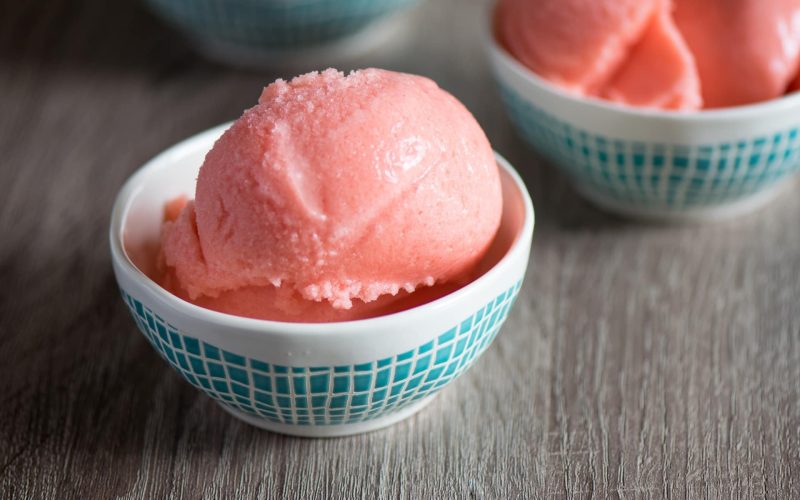If you’re a fan of sweet, refreshing treats, then you’ve likely come across Italian Ice.
As a calorie counter, you might be wondering, “Just how many calories are in Italian Ice?”
Before we delve into the specifics of its calorie content, let’s first understand what Italian Ice is and how it’s made.
What is Italian Ice?
Italian Ice, also known as “granita” in Italy, is a sweetened frozen dessert made from either fruit juice or fruit puree, sugar, and water.
It’s similar to sorbet and shaved ice, but its texture and flavor can vary depending on the preparation method.
Italian Ice is known for its smooth, creamy consistency that’s achieved through a unique freezing process.
This delightful treat is a staple in many Italian festivals and summer events, offering a refreshing escape from the heat.
How is Italian Ice Made?
Making Italian Ice involves a simple yet meticulous process. First, a mixture of water and sugar is created.
To this, fruit juice or puree is added, resulting in a sweet, fruity concoction.
This mixture is then poured into a freezing pan and left to cool until it becomes a slushy consistency.
During the freezing process, the mixture is stirred intermittently to prevent the formation of ice crystals, creating a smooth and uniform texture.
It’s this unique freezing and stirring process that sets Italian Ice apart from other frozen desserts.
Now that you have a better understanding of what Italian Ice is and how it’s made, you’re one step closer to discovering how many calories are in Italian Ice.
In the upcoming sections, we’ll delve deeper into the calorie content of this sweet, refreshing treat, examining the factors that influence its calorie count and offering tips on how to enjoy Italian Ice within a balanced diet. Stay tuned!
Understanding Calories
Before diving into the nitty-gritty of how many calories in Italian ice, let’s take a step back and understand what calories are and why you might want to count them.
What are Calories?
In simple terms, a calorie is a unit of energy. When you hear about calories in the context of food, it refers to how much energy your body can get from eating or drinking it.
Your body uses this energy to perform all of its functions, from moving to thinking to growing.
When you consume more calories than your body needs, it can store the excess as fat. This can lead to weight gain over time.
Conversely, if you consume fewer calories than your body needs, it can start to use stored fat for energy, leading to weight loss.
Why Count Calories?
Calorie counting can be a useful tool for managing your weight.
By being aware of the number of calories you’re consuming, you can balance it with the number of calories your body uses (your metabolism and physical activity) to maintain, gain, or lose weight.
Moreover, calorie counting can also help you understand portion sizes and make healthier choices.
For instance, knowing that a cup of Italian ice has fewer calories than a cup of ice cream might make you more likely to choose Italian ice.
However, it’s important to note that calories aren’t everything. The quality of the calories you consume matters, too.
Foods that are high in nutrients and low in calories, like fruits and vegetables, are an essential part of a healthy diet.
For more information on what calorie counting entails, check out our article on what is calorie counting.
In the next section, we will get into the details of how many calories are in Italian ice, your delicious dessert of choice.
Calories in Italian Ice
The refreshing taste of Italian ice is a delight to the taste buds.
Still, you might be wondering about its impact on your diet, specifically, how many calories are in Italian ice.
Breaking Down the Calories in Italian Ice
Italian ice, also known as water ice, is a fat-free sweet treat made from fruit juice, sugar, and water.
The calorie content is primarily influenced by these ingredients, especially by the amount of sugar used.
On average, a 4-ounce serving of Italian ice (approximately half a cup) contains around 120 – 130 calories.
However, the calorie content can change based on the specific ingredients and the brand.
| Serving Size | Average Calories |
|---|---|
| 4 ounces (half a cup) | 120 – 130 |
If you’re interested in understanding more about calorie counting, our article on what is calorie counting is a helpful resource.
How Serving Size Affects Calorie Count
Just like with any other food, the number of calories you consume from Italian ice is directly related to the serving size.
The more you eat, the more calories you consume.
For instance, if you were to double your serving size from 4 ounces to 8 ounces, you would also be doubling your calorie consumption from approximately 120 – 130 calories to 240 – 260 calories.
| Serving Size | Average Calories |
|---|---|
| 4 ounces (half a cup) | 120 – 130 |
| 8 ounces (one cup) | 240 – 260 |
Remember, while Italian ice can be a refreshing and lower-calorie option compared to other desserts like ice cream, portion control is still key to maintaining a balanced diet.
So, next time you’re about to enjoy your Italian ice, consider the serving size and its calorie content.
It’s all about finding the balance between savoring your favorite treats and managing your calorie intake.
Factors that Influence Calorie Content
As you continue to explore the topic of ‘how many calories in Italian ice,’ it’s important to understand the factors that influence the calorie content.
These factors include the ingredients used, the sugar content, and the flavor variations.
Ingredients Used in Italian Ice
The main ingredients in Italian ice are water, sugar, and flavoring, usually derived from real fruit or fruit juices.
The calorie content can vary significantly based on the type and quantity of these ingredients used.
For instance, if high-fructose corn syrup is used as a sweetener instead of natural sugar, the calorie content may be higher.
Similarly, the use of artificial flavorings can also impact the calorie count.
Sugar Content and Calorie Count
Sugar plays a significant role in determining the calorie content of Italian ice.
A single teaspoon of sugar has about 16 calories, and considering that Italian ice can contain several teaspoons of sugar, the calorie count can quickly add up.
For a detailed breakdown of the calorie content in sugar, you can refer to our article on how many calories in sugar.
Flavor Variations and Their Impact on Calories
The flavor of the Italian ice can also influence the calorie content.
For example, a lemon Italian ice might have fewer calories than a chocolate one due to the difference in ingredients.
Fruit-based flavors, especially citrus ones, are generally lower in calories as they contain natural fruit juices and less sugar.
| Flavour | Average Calories per Serving |
|---|---|
| Lemon | 100 |
| Strawberry | 120 |
| Chocolate | 150 |
Remember, understanding the factors that influence the calorie content can help you make better dietary decisions.
Whether you’re counting calories for weight management or simply trying to maintain a balanced diet, knowledge is your best tool.
Don’t forget to check out our other articles on calorie content in various foods, like how many calories in pizza, how many calories in eggs benedict, or how many calories in rice.
Balancing Deliciousness with Calorie Count
When it comes to enjoying food, it’s all about balance.
This truth holds especially when you’re considering the number of calories in your favorite treats, like Italian ice.
Enjoying Italian Ice within a Balanced Diet
Italian ice, with its sweet, refreshing flavor, can certainly be part of a balanced diet.
The key is moderation. Remember, when you’re counting calories, it’s not just about how many calories in Italian ice but also how it fits into your overall daily intake.
If you’re following a 2,000 calorie diet, for example, a serving of Italian ice that contains around 100-150 calories can be part of your diet without causing concern.
This, of course, depends on the rest of your meals and snacks for the day. It’s helpful to remember that balance and variety are crucial for a healthy diet.
Just like with any other food, be mindful of the portion size when enjoying Italian ice.
A small serving can provide the sweet satisfaction you’re craving without adding too many calories to your daily total.
Tips for Choosing Lower-Calorie Italian Ice Options
If you’re a fan of Italian ice but are watching your calorie intake, here are some tips for selecting lower-calorie options:
- Choose fruit-based flavors: Fruit-based Italian ice, like lemon or raspberry, tends to be lower in calories than creamier flavors like chocolate or vanilla. Plus, they offer a refreshing tang that’s perfect for a hot day.
- Watch the portion size: As with all foods, portion size matters. Opt for a small serving to satisfy your craving without going overboard on calories.
- Check the sugar content: The sugar content can significantly affect the calorie count. Some Italian ice options may be low in fat but high in sugar, so it’s always a good idea to check the nutritional information.
- Make your own: Making your own Italian ice at home lets you control what goes in it. You can use natural sweeteners or less sugar to reduce the calorie content.
Remember, enjoying food is not just about counting calories. It’s also about savoring the flavors you love.
By choosing wisely and eating in moderation, you can enjoy the deliciousness of Italian ice without worrying too much about the calorie count.
For more information on calorie counting, check out our article on what is calorie counting.








